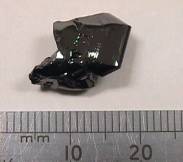
 instein 100 Years
2005
instein 100 Years
2005

 instein 100 Years
2005
instein 100 Years
2005


Gomes de Mesquita A.H. (1967) Acta Cryst. 23, 610-617.
Semiconductor for the 21st Century Highlights in SiC research Press The World, then Highlights in Frames window | 1824
Jöns Jakob Berzelius
suggested the idea that a Silicon-Carbon
chemical bond might exist. 1891 Eugene G. Acheson established a commercial process for making large quantities for the abrasives industry whilst attempting to synthesise diamond, coined the term Carborundum. 1893 SiC properties described 1905 Henri Moissan discovered SiC grains in the Diablo Canyon iron meteorite by measuring its density & its inertness to chemical reaction establishing the existence of the mineral in Nature. 1905 Albert Einstein Annus Mirabilis Special Relativity, Photoelectric effect, Brownian motion. 1907 H.J. Round produced the first Light Emitting Diode (LED) by applying 10V to contacts placed on a SiC crystal, observing yellow, green & orange luminescence at the cathode. 1912 Baumhauer used the word “polytypie” to describe the ability of SiC to crystallise into different forms varying only in their stacking order in one direction. 1949-1951 Frank developed the screw dislocation theory of polytypism, subsequent growth spiral observations on the {0001} face of SiC crystals by Amelinkx & Verma seemed to confirm the idea. 1954 Jagodzinski developed thermodynamic arguments and linked vibrational entropy & disorder to polytypism. 1955 Jan Antony Lely at Philips, Eindhoven developed a method of producing high quality vapour grown crystals that had potential for the semiconducting industry. 1958 First SiC conference held in Boston, USA. 1966 Verma & Krishna published the definitive book on the subject “Polymorphism & Polytypism in Crystals” including a chapter on the x-ray oscillation method identification of polytypes. 1975 Faulted matrix model proposed by Pandey & Krishna. 1984 Axial Next Nearest Neighbour Ising (ANNNI) interaction model used to explain polytypism. 1986 Fisher & Barnes described the use of Synchrotron Radiation Source X-Ray Diffraction Topography SRS-XRDT as an aid to study polytypic materials, in particular SiC. 1991 MOSPOQ conference held in Balatonzeplak, Hungary. Barnes et al. observed fine one-dimensionally disordered layers in SiC and a new 152H/456R long period polytype.(LPP) 1994, 1997 Aperiodic replaces Modulated Structures Polytypes & Quasicrystals MOSPOQ conferences- les Diablerets, Alpe d'Huez. 1995 Edge Topography used to study Polytype nearest neighbour relationships - result in American club sandwich model. 2000 APERIODIC 2000 conference Nijmegen Netherlands. 2001 SiC Networking: Swedish SiCEP programme, Electronics for Extreme Environments Network E3NET, Silicon Carbide Electronics for high Power high Temperature Applications SCEPTRE. 2005 Is there a finite limit to the number of polytypes in SiC ? Kelly Fisher Barnes equation t = 700 N -0.8 | |
ON THE ORIGINS OF SILICON CARBIDE |

|
OLDER THAN THE STARS.... |

|
A SHORT HISTORY OF TOPOGRAPHY |

|
21st CENTURY SEMICONDUCTOR |

|
What exactly is Moissanite ? Natural Moissanite is an extremely rare mineral that is even older than our solar system. Produced as supernova remnants or ejected from carbon rich, red giant stars these pre-solar SiC grains were trapped as micron size particles in meteorites that formed by the gravitational coalescence of interstellar gas.
Where does it come from ? Fragments of natural Silicon Carbide were found after chemical analysis, in a meteorite from the Diablo Canyon crater in Arizona, by Henri Moissan in 1905.Ref: Comptes Rendus Hebdomadaire Vol CXL , p405. In 1892 Eugene G. Acheson patented an electric furnance for producing synthetic Silicon Carbide which was used as a diamond substitute. Ref: Eng Patent 17911
What are its physical properties ? Moissanite or Silicon Carbide is an extremely hard man made material, the table below gives some typical values in comparison with diamond.
| Gemstone | Hardness Scale | Refractive Index | Thermal Conductivity W/cm/K | Specific Gravity |
|---|---|---|---|---|
| Cubic Zirconia | ||||
| Diamond | ||||
| Moissanite |
